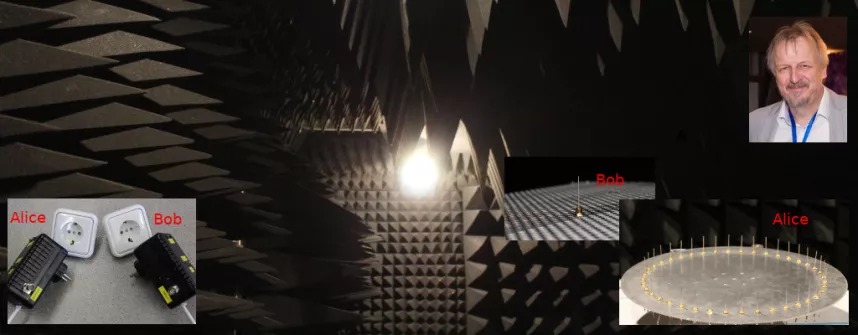Research project on physical safety of radio and cable transmissions
March 18, 2019
Our environment becomes increasingly networked, be it at our homes or inside industrial settings. Already now, it is assumed that a big share of devices has security deficits, mostly without the possibility of user-sided security updates. The Transmission Systems research group led by Dr.-Ing. Werner Henkel, Professor of Electrical Engineering, has chosen physical-layer security as one of the focus areas to counteract possible attacks.
The transmission channel itself is providing the necessary security without the need for key distribution or management. Solutions are being investigated applicable to wireless communications, be it in the same frequency band for both transmission directions or at different frequencies, and wireline communications, where especially powerline communication is of practical interest. Although wireless standards bodies and manufacturers are pushing for using wireless 5G or industrial settings, the data rates there are very low, usually just used for monitoring and control functions. Machines will have a power connection anyhow and powerline is then ubiquitously available. When ensuring secure data transmission over powerline, the medium is ideal for this application.
Physical-layer key generation builds on the reciprocity (bidirectional symmetry) of channel properties, be it the transfer function or the angles of arrival of wave components. Wireless and wireline channels provide this reciprocity up to uncorrelated noise and hardware imperfections, which can be addressed by key reconciliation methods. Keys result from a quantized transfer function, quantized locations of maxima or minima of transfer functions, or of quantized angles of arrival together with a mapping to key sequence patterns. A random change of the channel, e.g., in wireless due to moving mobile devices, will allow for a steady extension of the key sequence. Also, in powerline communications, although the cable connections are, of course, fixed, a randomization is possible. Due to a physically different location, eavesdroppers experience different channels and cannot recover keys of legitimate users.
Transfer functions, be it in wireless or wireline, are anyhow always determined and hence, physical-layer methods can easily be added to existing implementations. Now, on the contrary, putting oneself into the role of a possible eavesdropper, can one recognize and possibly even detect signals from devices themselves, maybe even following the trace of a signal inside the circuit, just measuring its wireless egress? Even if the signal at the output of a device is already protected by encryption, signals inside the circuit may not yet be, providing chances for an attacker. In a collaboration with a colleague at Hochschule Bremen and DSI Datensicherheit GmbH, a company in Bremen, we will investigate, to what extent one is able to analyze emitted signals thereby compromising security directly at the device side.
Our further works on physical-layer key generation and reconciliation and also signal discovery, classification, and detection are funded by German Research Foundation (DFG) and the Central Innovation Programme for Small and Medium-Sized Enterprises of the Federal Ministry of Economics and Energy (BMWi, ZIM), respectively. PhD positions are currently advertised.
Questions will be answered by:
Dr. Werner Henkel | Professor of Electrical Engineering
w.henkel [at] jacobs-university.de | Tel.: +49 421 200- 3157
